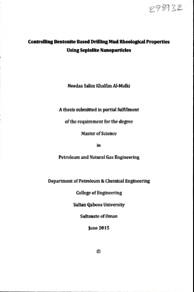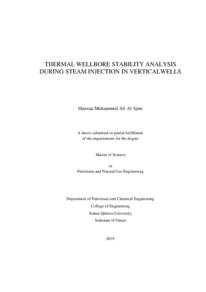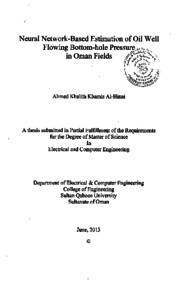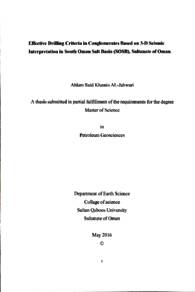وثيقة
Controlling bentonite based drilling mud rheological properties using sepiolite nanoparticles
الناشر
Sultan Qaboos University
ميلادي
2015
اللغة
الأنجليزية
الملخص الإنجليزي
Designing drilling fluid for drilling in deep wells and controlling its rheology are of great concern. Drilling in deep oil and gas wells is a challenge due to the high temperature and/or high pressure. Results from this project showed that the addition of sepiolite nanoparticle (size 50 nm) to the bentonite based drilling mud controlled and stabilized the rheology within a wide range of pressure from 500 psi up to 6000 psi and temperature from 50 °C up to 180 °C. This was compared to a base case which rheology was fluctuating and was not stable with increasing pressure and temperature. The effect of this new additive on the fluid loss and permeability reduction was studied using sandstone core flooding at reservoir temperature and pressure. The results showed that there was a reduction in the fluid loss by 15% compared with the base case. Also, the reduction of sandstone permeability caused by bentonite based drilling mud with sepiolite nanoparticle was lower than without sepiolite nanoparticle by 35%. Hence, sepiolite nanoparticle reduced the formation damage caused by bentonite drilling mud. Scanning Electron Microscope (SEM) was used to measure the sepiolite particle size. It was also used to figure out the mechanism of bentonite and nanoparticle plugging of sandstone pores. SEM images showed nanoparticle bridged sandstone pores and prevented bentonite from invasion into the formation. Hence, bentonite did not invade deep into the formation but it accumulated at the core face, formed a filter cake, and reduced the fluid loss compared with the bentonite based mud without nanoparticles which showed a deep invasion of bentonite particles in the formation.
الوصف
Thesis
المجموعة
URL المصدر
الملخص العربي
جاد سائل حفر مناسب لحفر آبار النفط والغاز العميقة يشكل مصدر قلقل. حيث أنه كلما زاد عمق البئر زادت درجة الحرارة و / أو الضغط مما يتسبب في تغيير لخصائص سائل أو طين الحفر. أثبتت نتائج هذا البحث بأن إضافة السيبولیت بحجم 50 نانوميتر إلى طين البينتونيات يساعد على المحافظة على ثبات الخصائص الريولوجية في درجات حرارة مختلفة (من 50 إلى 180 (C° وضغط مختلف (من 500 إلى 6000 (psi بالمقارنة مع طين البينتونایت بدون النانوسیبولیت حيث أن خصائصه الريولوجية غير مستقرة و غير ثابتة بارتفاع درجة الحرارة والضغط في هذا البحث تم عمل تجربة لمحاكة حفر الآبار وتم استخدام حجر رملي وكانت ظروف التجربة من ضغط وحرارة مشابهة لمكامن النفط. تم عمل هذه التجربة الدراسة تأثير إضافة النانوسيبوليت إلى طين البينتونايت في التقليل من فقدان سائل الحفر من الطين إلى طبقات الصخور وكذلك تأثيره في التقليل من نقص نفاذية الصخر. أثبتت النتائج بأن النانوسيبوليت قلل من فقدان سائل الحفر إلى الصخر بنسبة 15% وقلل من النقص في النفاذية بنسبة 35% مقارنة مع طين البينتونایت بدون النانوسيبوليت. بعد هذه التجربة تم أخذ صور للحجر الرملي باستخدام جهاز المسح الإلكتروني لمعرفة طريقة النانوسيبوليت والبنتونایت لسد مسامات الحجر الرملي. أظهرت النتائج بأن النانوسيبوليت شكل جسر على مسامات الصخر مانعا البينتونايت من النفاذ. لذلك فالينتونایات تجمع على وجه الصخر مكونا طبقة من الطين مما قلل من فقدان سائل الحفر. على العكس من ذلك فمع الحفر بطين البينتونایت بدون النانوسيبوليت نجد أن البينتونات دخل لمسافة أكبر مما أدى إلى زيادة فقدان سائل الحفر إلى داخل الصخر الرملي
قالب العنصر
الرسائل والأطروحات الجامعية





